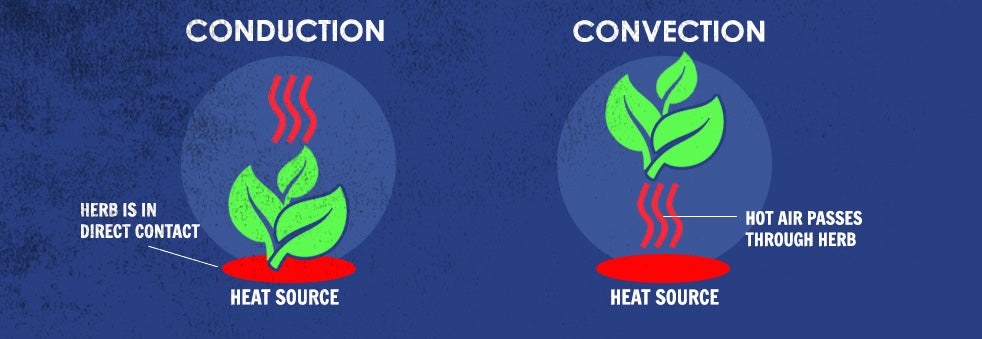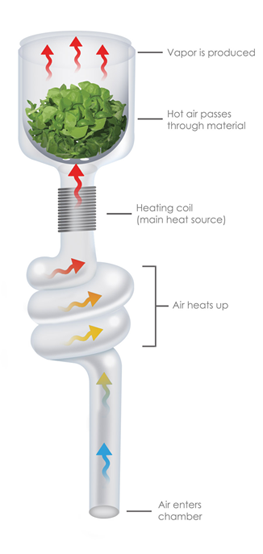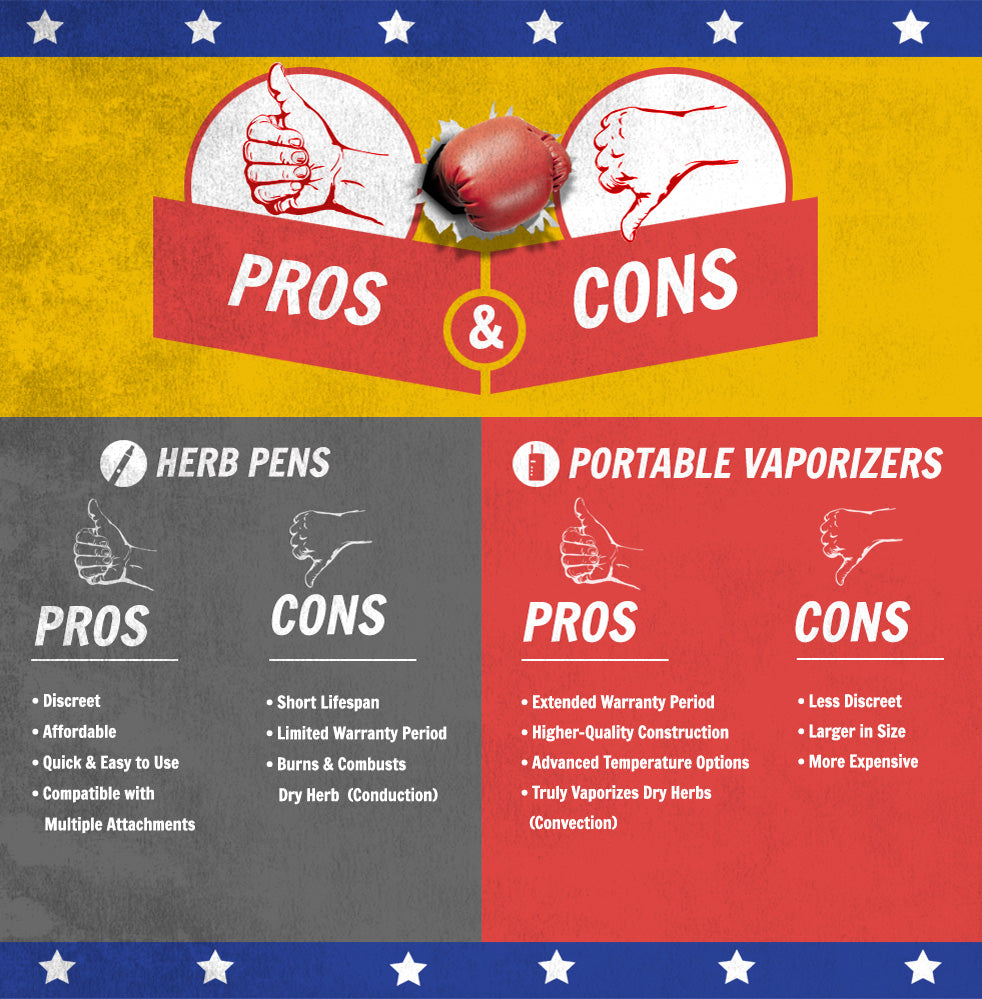Dry Herb Pens vs Portable Vaporizers
Herb pens represent a quick, discreet and convenient way to enjoy your favorite dry herbs on-the-go. Although commonly referred to as "vape pens", that name can be a little misleading, as these devices don't really vaporize. The distinction of being a true vaporizer is actually reserved for another class of products known as "portable vaporizers".

Heating Methods: Conductions Vs Convection
The main difference between herb pens and portable vaporizers is the way in which they heat plant material. Pen-style units utilize a method called conduction by transferring heat directly from the heating coil to your herbs. As a result of making direct contact with the heat source, combustion occurs and smoke is produced.
In contrast, portable vaporizers employ a method called convection, which heats herbs placed in a chamber by passing and circulating heated air through them. During this method, the material being heated never comes into direct contact with the heating element, but is instead essentially "cooked".
An easy way to understand how conduction works is by simply picturing a cup of coffee. When hot coffee is poured into a ceramic mug, heat is transferred directly from the hot liquid to the cup, thus heating the mug and causing it to be warm to the touch. The mug is "conducting" the heat directly from the coffee itself.
The simplest way to understand the principles of convection is to picture a hair dryer. The heating element inside of the hair dryer heats the air, which is then blown out and transferred from the hot air to your hair, which in turn heats and dries it. At no point does your hair ever come into direct contact with the heat source.

Now that we're familiar with the different types of heating methods, let's take a look at exactly how of these methods are applied to herb pens and portable vaporizers.
How Do Herb Pens Work?

When using an herb pen (like the AtmosRx shown above), dry material is placed into the chamber (or tank), which also typically houses the heating coil itself. It's important to realize that some (but not all) of your dry material will come into direct contact with the coil itself. Once the power button is pressed, the coil begins heating instantly, and will become red hot in a matter of seconds.
Unlike portable vaporizers, which are set to a preferred heat setting, and stay at a constant temperature for the duration of the session (baking all dry material evenly at one time), pen-style units require the power button to be pressed during each draw in order to activate the heating coil. This allows you to enjoy multiple sessions from a single packed chamber, as you're able to control when and how often the heating element is activated. The fact that herb pens heat instantly makes them ideal for quick-draws in public.
At this point, any herb that is touching the coil will essentially burn and combust in the same way it would if you were taking a lighter to it. The rest of the herb in the chamber will heat unevenly, and in some cases, not at all. Inspecting the remnants in the chamber after a session will reveal a mixture of charred, black ash and green bud that doesn't look like it's been heated at all. In order to make sure that dry material heats more evenly, it's a good idea to occasionally open the chamber during your session and mix the herbs around. This will help ensure that all packed material gets heated, and not just the portion that initially comes into contact with the heating coil. vapor has a large variety of herb pen vaporizers available.
How Do Portable Vaporizers Work?

When using a portable vaporizer, dry material is also placed directly into the chamber. However, unlike an herb pen, the heating element is not located in the chamber itself, but is instead located in the housing of the unit. Upon inhalation, hot air is pulled from the heating element, through the airpath (or vapor path) and into the herb chamber. This is the point at which convection occurs.
Because your dry material never comes into direct contact with the heating source, but is instead cooked below the point of combustion, the result is the production of pure vapor, with no smoke or harmful byproducts. This is what we refer to as a true vaporization experience, and is when the great benefits of vaporizing can really be enjoyed.
Unlike pen-style units, portable vaporizers do not require the power button to be pressed in order to activate the heating element. Instead, portables heat to a desired temperature which stays constant for the duration of the session, much like an oven. Additionally, most portables (unlike pens) give you the option to select from multiple different heat settings (typically between 350° and 420°F [175-215°C]). This gives the user more control over vapor consistency and potency. For example, heating herbs at a lower temperature will produce lighter, smoother vapor. Alternatively, heating herbs at a higher temperature will produce larger, more robust clouds.

The Evolution Of Herb Pens & Portable Vaporizer
As the vaporizer industry continues to grow, competition among manufacturers is fostering improvements and innovations at an unprecedented pace. Portable vaporizers are getting smaller and more versatile, while herb pens are becoming more advanced and starting to function more like true vaporizers.

At one time, it was unheard of for a portable vaporizer to be as compact and discreet as an herb pen. However, with new advancements in technology, we're now seeing portable units that are as small and sleek as many vape pens. Similarly, many herb pens (which have never been considered "true vaporizers") are now beginning to incorporate oven-like chambers and ditching exposed coils altogether, allowing users to receive the same types of benefits normally reserved for portable units.
Advancements and innovations like this are helping to blur the lines between herb pens and portables, adding to the overall versatility and appeal of each. You no longer need to trade off discretion for performance, or convenience for functionality. With certain pens and portables, it's now possible to get the best of both worlds. Even more exciting, is that as time progresses, these distinctions will become less and less apparent, resulting in a pen-style/portable hybrid with enchantments and versatility that we can currently only dream about.

So Which Type Should You Choose?
When deciding between an herb pen and a portable vaporizer, ask yourself the following question: "What am I ultimately looking to get out of my purchase?" The answer to this question will vary from person to person, and there's certainly no right or wrong answer. If you're unsure of exactly what you're looking for and what type of unit would best suit your needs, then please, consider the following:
If you're primarily looking for quick, easy and discreet way to enjoy botanicals while you're out and about, then an herb pen is a great route to take. Herb pens are simple to load and operate, and because they start heating with the push of a button, they're very conducive to on-the-go use, and can be hit with more discretion in public places than their larger, portable cousins. Think of a vape pen as a recreational tool that you can add to your herbal arsenal.
However, if you're looking to take advantage of all of the health benefits that a true vaporization experience can provide, then a portable vaporizer is your best option. While portables aren't quite as "on demand" as herb pens, they do (in most cases) offer more advanced heating options, and are typically higher quality products overall. If you rely on herbs for their medicinal value, but feel that combusting and inhaling smoke through traditional means of use is offsetting the benefits, investing in a portable vaporizer is the best choice that you can make.
